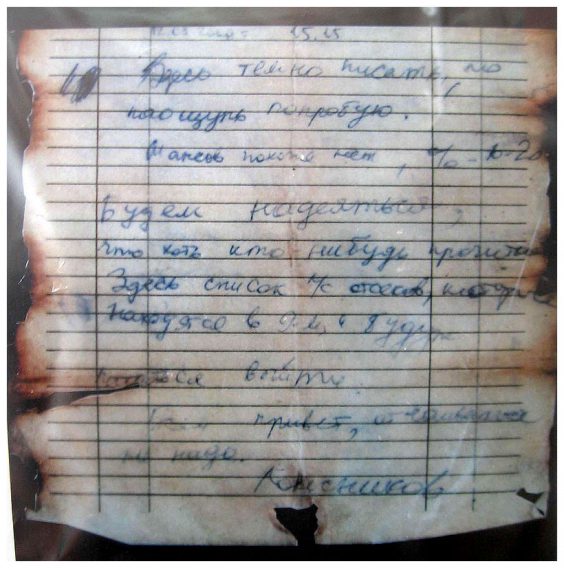The Kursk Submarine Disaster, Explained
by Sampsonia Way / August 23, 2016 / No comments

Note retrieved from the sunken submarine. Image via: Wikimedia Commons.
One of the reasons that Russian poet Anzhelina Polonskaya, ICORN writer-in-residence of the Frankfurt City of Refuge, had to leave her country was for writing a libretto for the Kursk submarine disaster. Her words were set to an operatic score and performed in Melbourne, Australia in 2011. What was intended as a commemoration for lost lives became a political act, and to protect herself, Polonskaya had to go into exile. Sampsonia Way compiled this primer to explain the political and historic contexts of the Kursk submarine disaster so that readers can better understand why it is a taboo subject in Russia.
What was the Kursk submarine?
The Kursk was a nuclear-powered Russian Navy submarine, the first vessel constructed after the collapse of the Soviet Union. The submarine’s design incorporated the best of Soviet nuclear submarine technology, and was the largest attack submarine ever constructed – so large it could defeat an entire group of US aircraft carriers.
On August 12, 2000, there were two explosions aboard the submarine while it was preparing to fire practice torpedoes while participating in Russian navy exercises. The explosions blew a large hole in the hub, killing most of the sailors. The submarine sank, and the remaining 23 sailors who survived the explosion were also lost.
Following the disaster, the Russian military and the Kremlin insisted that the Kursk was sunk by a collision with a Western submarine.
Why did the submarine sink?
The Russian government’s official conclusion reported that the first explosion was caused by a hydrogen peroxide leak from a fault in the torpedo’s casing, which then triggered the detonation of the submarine’s warheads. The Kursk was one of only a few ships in the Russian fleet authorized to carry a combat load of weapons at all times.
Other analyses of the disaster have cited the crew’s inexperience. The Kursk only completed one six-month mission during its five years in the Russian fleet, and the crew had never fired its torpedoes before.
Why weren’t the 23 survivors rescued?
At first, the Russian navy reported that everyone aboard the Kursk had died during the explosion. The American, British, and Norwegian navies offered to assist with rescue efforts, but it took two days for the Russian navy to accept their help. The delay meant that help only arrived seven days after the submarine sank.
Nearly ten days after the disaster, on August 21, Norwegian and Russian divers found the bodies of the survivors in the boat’s turbine room. A message retrieved from a captain’s body listed all of the survivors’ names and described their final hours aboard the submarine.
What were the political repercussions of the Kursk submarine disaster?
Russia’s handling of the submarine disaster made the Kremlin and the Russian navy look incompetent – a huge embarrassment for the country, which had long prided itself on its technological accomplishments, military might, and status as a global power. President Vladimir Putin was only four months into his presidency when the disaster happened. He waited five days before returning from vacation, leading to a steep drop in popularity among Russians.
The discovery that 23 sailors had survived the blast only to be lost when the submarine sank only made the situation worse. Seventy-seven percent of Russians thought that their government could have done more to save the crew.

A monument to the Kursk submarine in St. Petersburg. Image via: Wikimedia Commons.
Has it always been taboo to discuss the submarine?
During the crisis in Russia, there was nonstop reporting on the submarine disaster, with dramatic video from the sea floor and hotlines for friends and relatives to call for the most recent news. Private television networks sharply criticized the handling of the crisis by the military, the government, and even Putin himself – leading Putin to criticize the media, in turn, for its “unpatriotic coverage.” Putin learned his lesson, and following the Kursk submarine disaster the government began to create policies to control the media.
What were some of the repercussions of the Kursk submarine disaster?
Today, the Kursk is a taboo subject for writers in Russia. The sinking of the Kursk was the first incident that drew international attention to Putin, and the embarrassment probably influenced his handling of the media and public relations from then on. A politician who criticized Putin’s handling of the disaster was stricken from the election ballot as punishment. Russia began to attack its independent media outlets, leading to a decline in its press freedom. By 2003, there were no independent television stations left in Russia. Today, the official media continues to put forth nationalistic propaganda, drowning out any alternative reporting by independent voices.
How is the Kursk submarine disaster viewed within Russia now?
In the years following the submarine disaster Russians sharply criticized their government’s actions, but in the years since their attitudes have softened. Fifteen years after the Kursk submarine sank, 40 percent of Russians thought that their government did everything within its power to save the crew, and 28 percent of Russians think that Russia was right to reject initial offers of help from other countries. In 2010, those numbers were only 34 percent and 21 percent, respectively.




